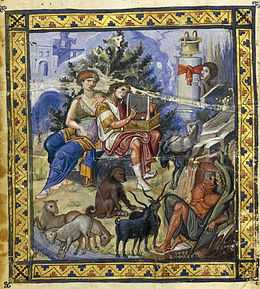Paris Psalter


The Paris Psalter (Paris, Bibliothèque Nationale, MS. gr. 139), designated by siglum 1133 (Rahlfs), is a Byzantine illuminated manuscript containing 449 folios and 14 full-page miniatures "in a grand, almost classical style", as the Encyclopædia Britannica put it. Together with Basil I's Homilies of St Gregory Nazianzus, the Paris Psalter is considered a key monument of the so-called Macedonian Renaissance in Byzantine art during the 10th century.
The most famous miniature depicts David playing the harp at the side of the seated female figure of "Melody" (illustrated, to the right). Around this central group are the figure of Echo, various animals charmed by music, and even a male figure symbolizing the town of Bethlehem. The whole composition was likely modeled on a Greco-Roman wall painting representing Orpheus charming the world with his music.
This and other miniatures are so Hellenistic in execution and so unlike the received notion of what medieval art in general and Byzantine art in particular should look like, that most 19th-century authorities dated the manuscript to the time of Justinian. The Byzantists Hugo Buchthal and Kurt Weitzmann, however, conclusively demonstrated that the book was created in the 10th century.
See also
- Castelseprio (frescoes in a related style)
- Macedonian Renaissance
- Macedonian art (Byzantine)
References
- Walther, Ingo F. and Norbert Wolf. Codices Illustres: The world's most famous illuminated manuscripts, 400 to 1600. Köln:Taschen, 2005.
- Steven H. Wander, “The Paris Psalter (Paris, Bibliothèque Nationale, cod. gr. 139) and the Antiquitates Judaicae of Flavius Josephus,” Word & Image: A Journal of Verbal/Visual Inquiry vol. 30:2 (June, 2014), pp. 90-103
External links
 Media related to Paris psalter at Wikimedia Commons
Media related to Paris psalter at Wikimedia Commons- The glory of Byzantium: Art and Culture of the Middle Byzantine Era, A.D. 843-1261, an exhibition catalog from The Metropolitan Museum of Art (fully available online as PDF), which contains material on the Paris Psalter (cat no 163)